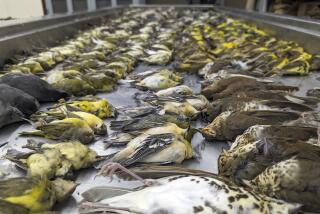In Midwest, Cowbirds Stick in the Craw of Songbirds : Environment: Some species are being pushed toward population collapse by the freeloaders, which lay eggs in other birds’ nests.
- Share via
WASHINGTON — The American Midwest has become a disaster area for migrant songbirds and a paradise for a feathered freeloader who tricks other birds into raising its young.
Songbirds that fly thousands of miles from South America to nest in the forests of the Midwest are being pushed toward population collapse by cowbirds that lay eggs in other birds’ nests and force the hosts to feed and nurture cowbird chicks.
A study published in the journal Science shows that migrant songbird populations are in steep decline in the Midwest. Naturalist Scott K. Robinson of the Illinois Natural History Survey says that parasitic cowbirds are the principal cause.
“Cowbirds are the most important culprits,” he said. A single cowbird female, which he called “the drabbest of the drab birds,” lays eggs in a dozen songbird nests and then flies away, he said. The songbird then tries to feed its young and those of the cowbird too. Usually the songbird young die.
“The cowbirds hatch earlier, grow faster and then crowd out the host young,” said Robinson. “The songbird young just starve to death.”
Robinson said the cowbirds are so successful because most of the forests in the Midwest are in small plots, or in strips along highways or beside farm fields.
Cowbirds spend most of their time in meadows, yards and fields and venture only a short way into forests in search of nests. If the woodlands are narrow, the songbirds--including tanagers, warblers, thrushes, vireos, flycatchers and grosbeaks--have no nesting sites safe from the cowbirds.
A survey by more than 125 researchers and assistants of 5,000 nesting sites in five states found that up to 50% of the songbirds were not successful in raising young. This is not enough to maintain the songbird population at those sites, Robinson said.
But the cowbirds did fine.
“Cowbirds are the most important culprits in the nesting failures of the songbirds,” Robinson said. “In a fragmented forest, the cowbird parasitism has a lot more dramatic effect than did predators” such as snakes that attack songbird nests.
The survey was done in Indiana, Michigan, Wisconsin, Illinois and Missouri.
Robinson said that when there were large forested areas in the Midwest, there were few cowbirds there.
“We believe that the cowbirds were very rare then,” he said. “They followed the herds of bison because they needed short grass to feed on. They were never in one area long.”
Songbirds migrate seasonally from South America and nest in the huge woods.
But when the Midwest forests were felled for farm fields and pastures, much of the region was turned into cowbird country. Migrant songbirds lost the protection of the deep forests and went into decline.
“These birds don’t have an evolutionary history of dealing with cowbirds,” Robinson said. “They haven’t learned to recognize that a cowbird egg is not their egg and that cowbird young are not their young.”
Most migrant songbirds, he said, “imprint on the young and take care of whatever is in the nest,” even if it’s a cowbird chick.
Some resident birds, however, won’t tolerate the freeloader.
“The Baltimore oriole will puncture a cowbird egg and throw it out,” he said. Robins also reject the cowbird egg. Both robins and orioles are thriving.
Robinson said the study shows that the problem could be corrected by establishing a network of forests no smaller than 20,000 acres. This is the minimum size, he said, to give the migrant songbirds a haven from the cowbirds.
More to Read
Sign up for Essential California
The most important California stories and recommendations in your inbox every morning.
You may occasionally receive promotional content from the Los Angeles Times.













